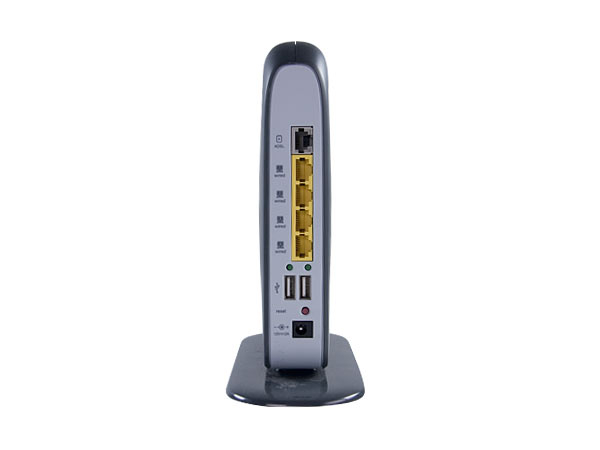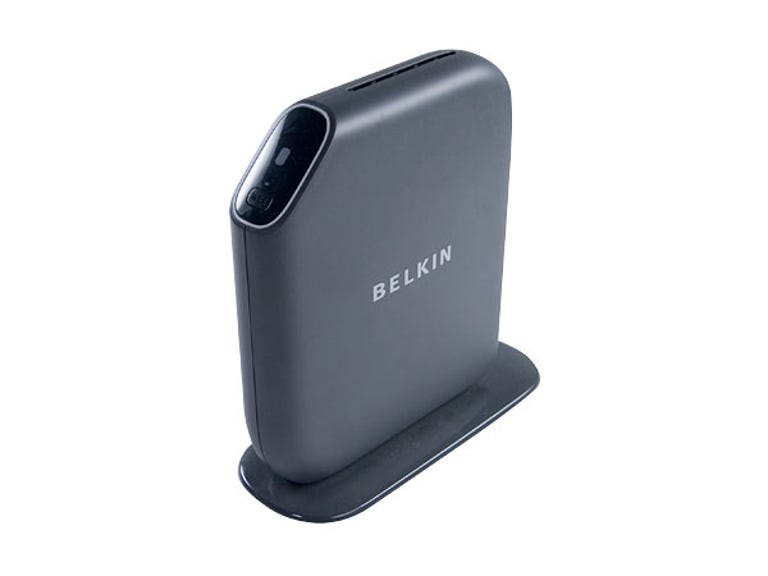 Why You Can Trust CNET
Why You Can Trust CNET Belkin Play Max F7D4401 review: Belkin Play Max F7D4401
The Play Max distinguishes itself by being a simultaneous dual-band modem/router with fast internal routing speed. Sadly, due to some extremely poor design decisions, high cost and being bogged down by software that runs on the PC rather than the router itself, the Play Max cannot be recommended.
Say what you will about the technical side of its products, Belkin has traditionally positioned itself towards the head of the design curve. However, its new range of routers takes a dramatic about-face, competing for one of the dullest products we've seen. The top is matte military grey, the base the same colour but glossy, and the primary feature is one large status light that blinks different colours, under which is a smaller light and button for WPS syncing. It feels like a prototype that shouldn't have left the labs.
The Good
The Bad
The Bottom Line
While we appreciate Belkin's attempts to move networking out from an arcane art to something simple, the single status light is almost useless, only indicating internet connectivity. Should you have a problem with the wireless, or need to diagnose cabled connections there are no lights at all — you'll have to go to the web user interface (UI).
Assuming everything actually works, Belkin includes both the default SSID and password on the bottom of the router for connecting to the wireless. Out of the box it runs WPA2, a decent precaution.
Specs at a glance
| Firmware tested | 1.00.45 |
|---|---|
| ADSL2+ modem | Yes |
| Annex M | Yes |
| 3G modem | No |
| Wireless protocols | 802.11b/g/n |
| Highest wireless security | WPA2 |
| WDS | No |
| Ethernet ports | 4x gigabit |
| USB print sharing/storage | Yes |
| Accessories | Ethernet cable, phone cable, CD containing quick-start guide, manual, software |
Connections

ADSL line, four gigabit Ethernet ports, dual USB ports for storage, reset button and power jack. There are no connection lights for the Ethernet jacks, and there's no power button. (Credit: Craig Simms/CBS Interactive)
UI and features
Belkin's UI hasn't changed that much over the years in terms of look. While the company's target market is more mainstream than tech savvy, the UI doesn't go out of its way to help newcomers to networking. There is a help page, but it's nothing more than a long glossary page that doesn't include a lot of the options available in the Play Max and no easy way to navigate other than scroll through the plethora of definitions — some of which aren't definitions, and basically say "don't touch". Take subnet mask for instance — yes, subnetting is a pain in the arse, but the following definition simply isn't helpful:
Subnet mask
There is no need to change the subnet mask. It is possible to change the subnet mask if necessary. Only make changes to the subnet mask if you specifically have a reason to do so.
Standout features include the ability to check for firmware updates, although we guess it checks a different server than the one hosting Belkin's website, as a new firmware was clearly available when the router told us there were no updates. It also supports MAC address cloning and guest internet access (so guests can get online, but won't see your private network).
Belkin's interface hasn't changed much for some time, and is easy enough to find your way around. (Screenshot by CBS Interactive)
There's also an ominous feature called "self healing". Wincing, we loaded the page and found it to be exactly what we thought it would be — scheduled restarting of the router at a user specified time. While all routers can get a little out of line and require a restart, we're not sure what to make of this little grievance being turned into a feature; at best, it shows Belkin doesn't have faith in the stability of its own routers.
Then there's the oddities; the Play Max won't allow SSIDs with spaces in them, and any change to the wireless settings results in a router restart, meaning all users are dumped offline. Why cabled users are punished for a wireless change, we can't begin to fathom.
Oh, crapps
Yep, it's another product with apps. Belkin offers a few tiers within its current router crop, each able to do something a little more than the last by offering "apps".
The Play Max has the complete set, although access to this requires you to install Belkin's software — you can't manage it through the router itself.
After putting an icon in the system tray called "Belkin Router Monitor", it installs a few other pieces of software and also sets up a device called "router", which can be accessed through Windows Explorer to see any external storage that's plugged in, and lets any web browser go directly to the web UI's IP simply by typing router into the address bar.
So far so good. The apps, sadly, aren't really worth it, and you'll need Belkin's software installed on your PC to use the majority of them.
The music streamer, called "Music Mover", is quite simply a UPnP server that exposes any music files it finds on any attached USB storage to a UPnP compatible player. You can choose to backup to that external storage too if you like through "Memory Safe", although being limited to USB speeds will be especially painful. "BitBoost" is simply QoS under a friendly name, allowing you to prioritise voice, games and videos if you so choose.
Then there's "Daily DJ", a music playing app that tries to build playlists automatically built on sentiment, and "Music Labeler", that automatically attempts to clean up your music tags. They seem to work fine, but how these relate to routers we're stumped to say.
Then there's the torrenting. As long as you've got external storage attached, you can in theory download torrents through the router while your PC is offline. The reality is far from the theory.
Belkin has chosen Vuze, formerly known as Azureus, to handle torrents. The software is installed on your PC and everything is managed from there, with the ability to later offload the torrent to the router. Or at least, it's meant to, but we could never get it to work, with Vuze consistently claiming that our router was offline. It looks like it's an auto update issue, but it's frustrating nonetheless. None of the torrents can be managed on the router either — the only option you have is to wipe items in the queue, which includes partially downloaded and complete files.
Don't be fooled by the feature list — the Belkin Play Max is not a replacement for a NAS in any form, and not being able to manage the features through the router itself is near criminal. We haven't tested it yet to see if its internal routing speed is as good as the Play Max, but if Belkin is on your shopping list we'd investigate the cheaper "Play" version, as it's still at least simultaneous dual band, and loses some cruft along the way.
Performance
After analysing the spectrum with InSSIDer, an empty channel of either 1, 6 or 11 is chosen for 2.4GHz wireless testing. The router is restricted to the 20MHz band and will only allow 802.11n clients. If possible, the MCS is set to 15.
We use iperf to determine throughput, running eight streams, with a TCP window size of 1MB, and an interval of one second. The test is run for five minutes in three different locations, on two separate occasions. The locations are in the same room as the router, one floor down around spiral stairs and with concrete walls and floors, and two floors down under the same conditions.
The wireless throughput is tested using three chipsets, the Atheros AR5008X, Ralink RT2870 and Intel 5100AGN, then all results are averaged.
(Longer bars indicate better performance)
We've included two scores here, one without the Intel 5100AGN, one with. This is due to the Belkin not accepting connections from the 5100 when set to accept N clients only — we were only able to connect when this was off, resulting in 802.11g speeds. Without the Intel it puts in a strong showing, although its distance performance isn't the best as we can see by the location three scores.
(Longer bars indicate better performance)
Location three is particularly challenging for 5GHz. The Linksys is the only one that makes a stable connection, and even then performance isn't great. We should also note that Linksys' own external dongle was all it would connect to — both the in-built Atheros and Intel chipsets failed to make a connection. The number shown above is the average over the three connections, but obviously the zero scores distort the results here: the actual throughput on the Linksys dongle for the Linksys and Netgear modem routers was 13.50 and 0.18Mbps respectively.
Belkin's Play Max is the only 5GHz modem/router we've tested with fast enough internal routing to take advantage of gigabit to wireless speeds. It seems Linksys and Netgear have chosen to hold out, instead leaving the faster speeds for their WRT610N and WNDR3700 dedicated routers.
ADSL performance is simply measured by the sync speed on an Internode ADSL2+ connection to the St Leonards exchange, on Internode's very high speed profile. If the connection remains stable over a period of time, the sync speed is recorded.
(Longer bars indicate better performance)
Power consumption
We measured power consumption using a Jaycar mains digital power meter. It's important to note here that due to limitations of the meter, measurements are limited to values 1W and greater, and are reported in 1W increments.
The wireless radio was turned on, and an iperf test begun for measurement, using one wireless client and one wired.
| Juice Box |  |
|---|---|
| Transmitting | 14W |
| Idle | 12W |
While most routers idle around 7W and at most get to 11W while transmitting, Belkin's Play Max is most definitely not an eco saver, being the most power hungry modem/router we've tested to date. It also gets quite warm, perhaps a side effect of all this power draw and no active fans.
Warranty
Belkin covers the Play Max for three years, a very competitive term for routers. You will need to contact Belkin to arrange a product replacement.
Conclusion
The Play Max distinguishes itself by being a simultaneous dual-band modem/router with fast internal routing speed. Sadly, due to some extremely poor design decisions, high cost and being bogged down by software that runs on the PC rather than the router itself, the Play Max cannot be recommended.



